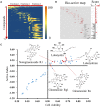Screening and Identification of Cardioprotective Compounds From Wenxin Keli by Activity Index Approach and in vivo Zebrafish Model
- PMID: 30483130
- PMCID: PMC6243390
- DOI: 10.3389/fphar.2018.01288
Screening and Identification of Cardioprotective Compounds From Wenxin Keli by Activity Index Approach and in vivo Zebrafish Model
Abstract
Wenxin Keli (WXKL) is a widely used Chinese botanical drug for the treatment of arrhythmia, which is consisted of four herbs and amber. In the present study, we analyzed the chemical composition of WXKL using liquid chromatography coupled with high-resolution mass spectrometry (LC-HRMS) to tentatively identify 71 compounds. Through typical separate procession, the total extract of WXKL was divided into fractions for further bioassays. Cardiomyocytes and zebrafish larvae were applied for assessment. In vivo arrhythmia model in Cmlc2-GFP transgenic zebrafish was induced by terfenadine, which exhibited obvious reduction of heart rate and occurrence of atrioventricular block. Dynamic beating of heart was recorded by fluorescent microscope and sensitive camera to automatically recognize the rhythm of heartbeat in zebrafish larvae. By integrating the chemical information of WXKL and corresponding bioactivities of these fractions, activity index (AI) of each identified compound was calculated to screen potential active compounds. The results showed that dozens of compounds including ginsenoside Rg1, ginsenoside Re, notoginsenoside R1, lobetyolin, and lobetyolinin were contributed to cardioprotective effects of WXKL. The anti-arrhythmic activities of five compounds were further validated in larvae model and mature zebrafish by measuring electrocardiogram (ECG). Our findings provide a successful example for rapid discovery of bioactive compounds from traditional Chinese medicine (TCM) by activity index based approach coupled with in vivo zebrafish model.
Keywords: Wenxin Keli; arrhythmia; cardioprotection; drug screen; zebrafish.
Figures





References
LinkOut - more resources
Full Text Sources
Molecular Biology Databases

